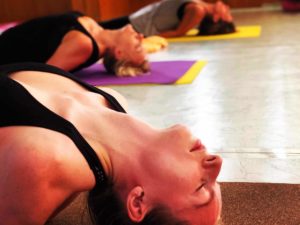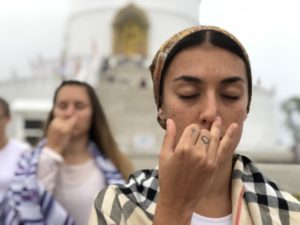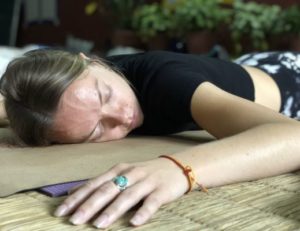How to sit for meditation properly is different for every person due to individual body compositions, limitations and habits producing special needs for every practitioner. Observing proper sitting guidelines for meditation will deepen your practice and allow you to sit for as long as you wish for. When we can sit in a meditative posture without any discomfort, we can focus our mind on the stillness within without being distracted by physical distress. We aim for a stable, comfortable position, a posture that does not make you want or need to move.
How to sit – guidelines for the lower body
The knees should be relaxed, without tension and at the same height as your hips or lower. Let your lower legs rest on the ground, it gives you more stability and distributes your weight evenly. Your hips should be free and your spine balanced on your sitting bones. Be steady on whatever surface you use as sitting ground, don´t let it be too hard nor too soft. You lower back should not overarch nor round but be straight, firm, and supporting the rest of the spine. Make sure your lower spine is in the same position as when you stand up. These rules apply for all meditation postures. Whether you are in a crossed-legged or kneeling position, on a chair or supported surface, these points of corporeal reference should not be modified as they allow the spine to be straight.
How to sit with a straight spine
In order for energy to move freely through the body, up the spine, and to the upper chakras, the spine must be erect. This facilitates upward energy transmission while at the same time it promotes deep belly breathing that is indicative of proper meditation. A straight spine has a double S-shape and gives more space between the vertebrae. Make sure not to tilt to the one or the other side, nor twist the body out of line. The crown of the head is in one line with the root of the spine.
Propper meditation posture with a relaxed upper body
Let the chest be open, no leaning forward, backwards, or downwards otherwise the spine will lose its integrity. Your shoulders should hang down relaxed, the hands resting on the legs. The neck should be long, the chin tucked in slightly and the downside of the chin parallel to the ground. The jaw should be loose and the face tension free.
No sleeping limbs, let the energy flow
During meditation, the body should be calm, in a state of equilibrium. Should any body part become numb, then seek a posture that keeps the energy flow freely through your body. There might be some trial and error in the beginning, but be sure to find a meditation posture that does not pinch any nerves. In case your leg falls asleep just stretch it out and let it come alive again, never remain with a numb limb! Listen to the signals of your body.
How to sit for meditation using support
Don´t be shy to use support for your sitting. As most people from the west are not used to sitting on the ground, in the beginning it might be better to start sitting on a chair for meditation. If you prefer to sit on the ground be aware that our hips are mostly not equally open on both sides. So you might protect one of your knees with a cushion or a Yoga block and prevent any strain on your knee joints or ankles. Use as much height as necessary in order sit up straight and to keep the hips free. With ongoing practice, the height will come down bit by bit and you will have to adjust your sitting position from time to time.
Change the sides in cross-legged sitting
Let your body become balanced. Sitting with crossed legs, we prefer one side to be up or in front. Change the legs every day or in every meditation session. This will balance your body and help your hemispheres of the brain to harmonise as well. It supports the equal flow of solar and lunar energy and improves the relaxation and promotes deeper states of meditation.
To learn all the fundamentals about meditation join our Meditation Teacher Training in Nepal or India.



